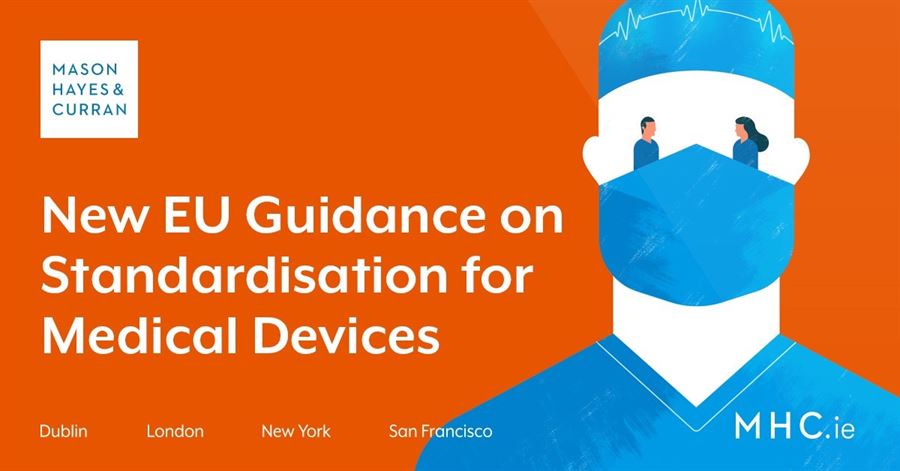
The European Commission’s MDCG has issued new guidance explaining the role of standards in the medical devices sector (the Guidance). The Guidance sets out the governance structure for harmonised European standards (hENs), as well as the benefits of using hENs to demonstrate compliance with the essential requirements laid down in the applicable EU medical devices legislation. The Guidance also addresses the concept of ‘state of the art’, which must be taken into account under EU legislation on medical devices to ensure compliance with certain health, safety and performance requirements.
The current EU legislative framework on medical devices is based on the principles of the ‘New Approach’ and the ‘New Legislative Framework’, which define the essential requirements on health and safety which must be met before medical devices can be placed on the EU market. The Guidance explains that hENs play an important role in providing technical solutions in support of those essential requirements where the legislation is otherwise silent on how those requirements should be met. The Guidance notes that hENs contain an ‘Annex Z’, which indicates the relevant legal requirements covered by the standard for each piece of EU legislation for which they may demonstrate conformity.
Guidance
The Guidance describes the process used by the European Commission when issuing standardisation requests to the relevant European Standardisation Organisations for medical devices, particularly CEN and CENELEC. The standardisation requests relate to the development of specific standards which prescribe technical solutions in support of the essential requirements of the applicable legislation. Therefore, medical devices which are produced and designed according to the applicable hENs benefit from a presumption of conformity with the relevant essential legal requirements. Despite the obvious benefits afforded by the presumption of conformity, reliance on standards in the medical device sector remains voluntary in accordance with the purpose of standardisation as set out in the Regulation on European Standardisation 1025/2012:
“The primary objective of standardisation is the definition of voluntary technical or quality specifications with which current or future products, production processes or services may comply.”
In practice, a manufacturer can therefore choose to demonstrate compliance through the application of the technical solutions provided by hENs, by non-harmonised European standards, or by other international or national standards. A manufacturer may also choose to develop its own technical solutions, provided that it can demonstrate that the alternative non-harmonised means comply with the legal requirements that apply to the product.
There are, however, some important exceptions to the principle of voluntary compliance with standards for the symbols and identification colours used to convey compulsory, regulated information to end users. This information must conform to the relevant hENs as stated in the Annexes of the applicable EU medical devices legislation.
The Guidance also provides useful insights into the concept of ‘state of the art’, which must be taken into account in order to demonstrate the compliance of a product with certain health, safety and performance requirements as set out under the applicable EU medical devices legislation. As it is a complex concept with no actual legal status, the Guidance warns that conforming to the most recent version of a standard not listed in the Official Journal of the EU does not automatically imply compliance with the requirements in the applicable EU legislation, if no further evidence is provided in the technical documentation of the product.
Conclusion
With the recent implementation of the MDR, this MDCG Guidance provides a timely reminder of how harmonised EU standards can help producers meet the essential health, safety and performance requirements set out in the applicable EU legislation. Medical device producers are encouraged to ensure that their compliance programmes incorporate the latest versions of the hENS to ensure continued conformity with the corresponding essential legal requirements set out in the applicable EU medical devices legislation.
As confirmed in the Guidance, the various standardisation mandates issued by the Commission to CEN and Cenelec in relation to the old Directives expire with those pieces of legislation. CEN and Cenelec have recently accepted a standardisation request from the European Commission to adopt and list standards that will be recognised under the MDR and the IVDR. The first of these harmonised standards have now been published in the Official Journal of the European Union in respect of the MDR on 19 July 2021 (OJ L 256, 19.7.2021, p. 100) and the IVDR on 20 July (OJ L 258, 20.7.2021, p. 50). The publication of these and further harmonised standards is something that manufacturers should continue to monitor closely.
For more information, please contact a member of our Life Sciences team.
The content of this article is provided for information purposes only and does not constitute legal or other advice.



